When we hear this 100% Quebecois proverb, we forget how sarcastic it actually is. An emphatic no: what’s good for the goose is not necessarily good for the gander. A simple proverb to illustrate that all too often people don’t consider the objectives of a promotional item.
For example, in order to reach your customers with your brand, a promotional item may be seen differently when presented at various shows and events. Or a promotional item can be specifically targeted to a customer segment and using it in all kinds of ways will make you look like a company lacking imagination and innovation.
To maximize your promotional ROI
In addition to the visibility of your promotional item, there are several things to consider. Here are some of them:
- What is your target audience? Future customers (students), future customers (prospects), current customers, employees, etc. Better yet, the item should have a feminine, masculine or neutral signature
- For what event is the object intended? And what is its use time-wise? For example, before a show, it’s easy to send a promotional article as an invitation to current customers. At the show, another promotional item can be used as a reminder or simply to promote new products. At the end of the show, as a follow-up, an impactful promotional article can reap much greater results than a simple email and can really create a climate of trust. In short, by doing things differently than the competition, you become the best!
- What is the object’s long-term promotional value for your customers and prospects? For example, a pencil is nice, but it’s even better if it stands out from low-end pens. Better still if the object actually sits on a desk or is used by your customers day-to-day, rather than by their children.
- Trends and the shelf life of your promotional items. Two elements that seem obvious, but it does make me laugh a little when a client tries to unload their old holiday stock. Shelf life also refers to promotional initiatives, which were in style last year and are much less so this year. Using the same items year after year can make you look like a company that lacks vision.
- Costs, and your budget for purchasing your items. Complex factors that must be considered objectively. For example, having a presence in a fashion trade show often costs $3,000 to $5,000 for a kiosk. If you add in representation expenses, printing, accommodation and meals, the amount can sometimes double. At that point, defining a promotional item micro-budget isn’t always a good choice as a business strategy.
A proverb that speaks volumes
The Quebecois proverb “What’s good for the goose is good for the gander” is simply a reminder to help you better define the potential and reach of your promotional items. Better yet, contact me at 438 257-1330. My 19 years of experience can make a difference and help you achieve the performance and results you desire!

